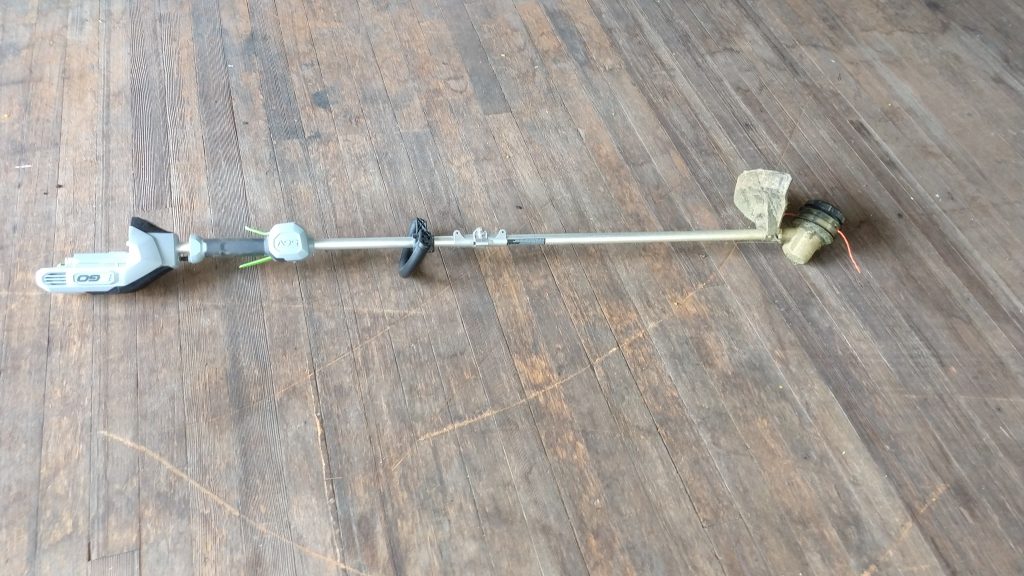
You might not know that string trimmers (aka weed whackers) have two separate designs. One is called straight shaft, while the other is curved shaft. It’s important you understand the pluses and minuses of each portable battery model before you buy a battery powered weed eater – otherwise you might choose poorly.
This article will cover the pros and cons of each, along with the different power types for a trimmer. By the time you are done reading, you’ll be a pro about all things string trimmer!
What is the difference between straight and curved shaft?
Straight-shaft and curved-shaft string trimmers have the same overall purpose but are different in design. The main difference between the two types is the design of the shaft. Straight-shaft models have a straight shaft. They are also usually shorter and have more power because of a gearbox connection. These are usually what a pro landscaper would use for weed eating around a yard.
Curved-shaft weed eaters have a longer shaft and have added height. The main advantage of a rounded shaft is its easy maneuverability. For this reason, the curved-shaft trimmers are recommended for homeowners with smalller lawns.
How About Cost?
When it comes to cost, straight-shaft trimmers are more expensive than curved-shaft trimmers. While straight shaft weed eaters are initially more expensive, they generally are better made and will last more in the long run. Keep that in mind when you are shopping for a weed whip.
A curved-shaft string trimmer will have more torque, but it will also have less power. Because the garden tool is made with a plastic drive shaft inside the shaft tube, they tend to wear out quicker than a straight shaft tool.
A curved-shaft trimmer will be more convenient in tight spaces, while a straight-shaft one is more suitable for yardwork with a lot of fixtures.
Is There A Difference In Versatility Between Trimmer Types?
Straight-shafted string trimmers are more durable and versatile. For instance, a curved-shaft trimmer can cut trees and bushes that are too high. You need to add string trimmer blades to do this, but it can be done. You shouldn’t try this with a curved shaft, however.
This type of trimmer is difficult to transport, but it does offer more versatility than a curved-shaft one. The straight-shafted version is easier to use, but it is bulkier and can be cumbersome to transport.
Do engines and motors enter the equation at all?
Gas-powered string trimmers are less environmentally friendly than other types of trimmers, and they are a pain to start vs their electric countrparts. They use gas to produce more power at the cost od stressing the user’s ears. However, gas-powered string trimmers are very convenient for trimming thick vegetation. It is also more expensive than other types, but if you’re willing to spend a little more, this type of string trimmer is a great choice.
Another major benefit of gas-powered string trimmers is the increased versatility they offer. A gas-powered trimmer will have more torque and cutting power than a cordless model. As long as you have the necessary experience and know what you’re doing, you’ll be able to trim your lawn in no time.
A number of people have found that using cordless string trimmers are more convenient than corded ones. There’s no power cord on these string trimmers. These tools are powered by batteries that run on a lithium ion. Most battery-powered string trimmers last for 15 to 60 minutes before needing to be recharged. The batteries can be charged by plugging them into a wall outlet. Some fast chargers take less than half an hour to fully recharge a device. A positive of cordless trimmers is that you can use multiple tools from a single battery.
Another benefit of cordless trimmers is that they are easier to use than corded models. Gas-powered models are quieter and don’t vibrate as much. These trimmers also have a long history and are very reliable. While they are slightly more expensive than corded models, many people find that they don’t need to charge their equipment often. This is one of the major benefits of cordless string trimmers.
While gas-powered trimmers are more convenient, they have some disadvantages as well. They use gas and oil, which can be harmful to people. Moreover, they are noisy, making them unsuitable for use in homes. If you’re a gardener, having a cordless trimmer is a great idea. However, it’s also important to remember that gas-powered trimmers are more expensive than their corded counterparts.
A key difference between curved-shaft and straight-shaft cordless string trimmers is the battery voltage. A curved-shaft model has a higher initial battery voltage, whereas a straight-shaft model needs a lower one. Both types are effective for trimming yards and can be converted into an edger if needed. The curved-shaft weed eaters are better at reaching around obstacles than straight-shaft ones.
Other Uses
A string trimmer can also be a handy tool for removing tree bark. Besides being useful for trimming trees, a string trimmer can also transform into an edger. This feature helps you reduce your lawn-care costs. Furthermore, many string trimmers come with optional add-ons, such as edgers and leaf blowers. So, you can save money on additional yard tools by purchasing a single machine.
Conclusion
While most people check out cutting width and cutting string diameter when shopping for a weed whacker, they often forget to look at the shaft type. That’s a mistake – it’s an important decision in the buying process.
Hopefully this article has given you enough information to arm you with the data you need the next time you are on the market for a string trimmer. Thanks for reading!